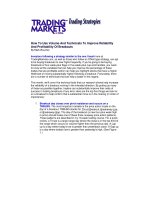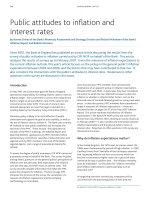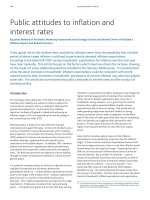Tài liệu Interim Final Rule, Savings and Loan Holding Companies 76 Fed. Reg. 56508-56606 (Sept. 13, 2011) doc
Bạn đang xem bản rút gọn của tài liệu. Xem và tải ngay bản đầy đủ của tài liệu tại đây (186.42 KB, 5 trang )
C. Dawn Causey
(202) 663-5434
November 7, 2011
Jennifer J. Johnson, Secretary
Board of Governors of the Federal Reserve System
20
th
Street & Constitution Ave., NW
Washington, DC 20551
Re: Interim Final Rule, Savings and Loan Holding Companies
76 Fed. Reg. 56508-56606 (Sept. 13, 2011)
Dear Ms. Johnson:
The American Bankers Association (ABA) welcomes the opportunity to comment on the Board of
Governors of the Federal Reserve System (Board) interim final rule addressing a number of transition
rules including new Regulations LL and MM for savings and loan holding companies (SLHCs), including
capital adequacy assessments. This comment letter focuses on Regulation MM (mutual holding
companies (“MHCs”)); a separate letter addresses Regulation LL. ABA represents banks of all sizes and
charters and is the voice for the nation’s $13.3 trillion banking industry and its 2 million employees.
Institutions directly affected by the proposal are strongly represented in ABA’s membership and
participated in the development of this comment letter.
The interim final rule transfers the regulation of MHCs to the Board’s regulatory framework and
attempts to preserve those items of statutory difference between the Home Owners Loan Act (HOLA)
and the Bank Holding Company Act (BHCA). It is a difficult task and we commend the Board’s efforts.
ABA notes that the transfer and supervision of MHCs will provide opportunities for greater
understanding as the Board and the mutual industry learn from each other. During this learning period,
ABA urges the Board to exercise supervisory discretion while systems and expectations are harmonized.
As noted in conversations with Board staff, the industry and the Board are both learning as the process
evolves.
Mutuality
Mutual savings banks are some of the oldest savings institutions in the country dating back to the early
1800s
1
. They capitalized on the antipathy toward the earlier banks due to among other issues the
experiences with paper money and colonial bills of credit
2
. While Bank of New York may be the oldest
continuously operating national bank (opened in 1784)
3
, the New England savings banks are quite proud
of their continuous service to their communities approaching 200 years. The “youngsters,” the federal
savings associations, date their existence to the Home Owners Loan Act of 1933, and at one time all
1
Weldon Welfling, Mutual Savings Banks; The Evolution of a Financial Intermediary, (Case Western Reserve,
1968).
2
Id., at p. 12.
3
(
2
federal savings associations were mutual in form. Attached to this comment letter is a short primer on
mutual institutions.
The universe of mutual savings associations has waxed and waned with the history of the United States
and the needs of communities and businesses served. Those remaining in mutual form have withstood
World Wars, depression, recessions, boom times and stagnant growth. They are both federal and state
chartered institutions and while their current numbers have been dwindling (ABA’s website cites 655
mutuals including 162 mutual holding companies holding more $273 billion in assets while other sources
list 679 mutuals, nonstock MHCs, and public MHCs),
4
there is a broader universe of similar institutions
that are potential mutual savings bank charters – credit unions. The similarities between federal savings
associations and federal credit unions are numerous including their focus on the long-term and their
community base. And, like mutual savings banks, credit unions grow through retained earnings. There
are 7, 442 credit unions in the United States including 173 with assets over $1 Billion Dollars holding
$449.1 Billion Dollars in assets.
5
Conversions of credit unions occur at a single-digit pace along with
contra conversions (mutual savings banks to credit unions – most recent announcement is Trivent
Financial for Lutherans
6
) Credit union conversions to a mutual savings bank charter peaked in 2001
before the NCUA adopted a number of restrictive rulemakings.
The purpose of the recitation of history and identification of the broader mutual industry is to place the
MHC form into context. Creation of the MHC dates to the enactment of the Competitive Equality
Banking Act of 1987. The purpose of the MHC is to provide a mechanism that preserves the mutual
charter while providing a means for acquisitions, controlled capital raising, and flexibility to offer other
financial services. Many MHCs have not issued minority shares. The industry continues to explore the
flexibility of the charter and its many benefits. It provides needed support without raising more funds
than necessary or deployable – a means of providing prudent capital to well managed entities while
maintain their local focus and presence. For these and the many endeavors the industry has put the
MHC charter to use, ABA respectfully encourages the Board to view the MHC as a positive option for
the mutual industry.
Regulation MM
The interim final regulation moves the regulatory provisions governing MHCs from the OTS regulations
to the new Board regulation MM. Most of the provisions of the prior OTS rules remain including the
ability of the supervisor to charter a new institution as part of the creation of the MHC. This authority is
intrinsic to the MHC charter and while clearly envisioned by the transferred regulations, the industry
would find it useful if the regulations included a clear statement in the preamble or regulation to that
effect.
4
“Today’s Mutual Community Banks 2011 Fact Sheet”.
5
NCUA
6
(
3
The Dividend Waiver
For MHCs and mutuals, the section that gives them the most pause, is the dividend waiver. The ability
to raise targeted amounts of capital and use of the holding company structure to make acquisitions of
lines of business and other depositories is a useful tool in the strategic planning and growth of mutuality.
The Board has dealt with dividend waivers for years and approaches it from its “source of strength”
viewpoint. It is difficult to understand why a holding company that must serve as a source of strength to
the subsidiary savings association would waive dividends that might provide the basis for that support.
As in most things, the issue is a bit more complicated than it may appear at first blush.
Why Are Dividends Waived?
Historically, the ability to waive dividends enabled minority stock MHCs to pay a higher dividend
necessitated by less attractive nature of the investment due to the minority status of the stock. Now,
dividends are much more reflective of the market and the yields are similar in amounts to dividends paid
in fully stock institutions. However, there are other practical reasons that remain today for waiving
dividends to the MHC. Because little or no activity is conducted at the MHC level, capital lies dormant
subject to taxation (a second time) and erosion. Passive capital may not be the best source of strength.
ABA suggests that the Board consider the strength of the mid-tier holding company as an alternative to
the MHC. Most minority stock MHCs have a mid-tier holding company and it is this entity that is most
readily available to support the depository institution, not the MHC top tier. Placing funds in the top
tier may limit their availability and make prudent deployment and investment more cumbersome both in
terms of time and expense. ABA respectfully suggests that the existence of the mid-tier may change the
dynamic and solve the source of strength concern in the dividend waiver discussion.
Overlapping Boards, Stock Ownership and Fiduciary Duties.
The OTS regulations and Section 625 of Dodd-Frank Act require the board of directors to “expressly
determine that a waiver of the dividend by the mutual holding company is consistent with the fiduciary
duties of the board of directors to the mutual members of the mutual holding company.”
7
The Board is
concerned that overlapping boards at the subsidiary institution and MHC level (or mid-tier) may provide
an inherent conflict of interest as well as directors maintaining ownership interest in the bank and
benefiting from the dividend waiver. ABA respectfully suggests that overlapping boards and stock
ownership are extremely common and encouraged in most lines of commerce. Investors often want to
know that management and the board has a vested interest in the company doing well because their own
capital is at stake. Employee stock plans provide a similar incentive to employees to want their company
to do well. Regulation MM appears to consider the denial of one group’s right to receive dividends by
the other groups that receive enhance dividends presents a conflict of interest. To overcome that
conflict, Regulation MM adds a member vote.
The first issue presented is who or what is being protected at the MHC level. The mutual interest that is
represented has no right to the capital at the MHC other than in the case of a liquidation.
7
12 U.S.C. 1467a(o)(11)(D)(ii).
(
4
The capital issue was decided in the context of tax law and whether the accumulated surplus of a mutual
was taxable income to a depositor. The U.S. Supreme Court ruled in Society for Savings v. Bowers, 349 U.S.
143(1955) on the ownership issue:
The asserted interest of the depositors is in the surplus of the bank, which is primarily a reserve
against losses and secondarily a repository of undivided earnings. So long as the bank remains
solvent, depositors receive a return on this fund only as an element of the interest paid on their
deposits. To maintain their intangible ownership interest, they must maintain their deposits. If a
depositor withdraws from the bank, he receives only his deposits and interest. If he continues,
his only chance of getting anything more would be in the unlikely event of a solvent liquidation,
a possibility that hardly rises to the level of an expectancy. It stretches the imagination very far
to attribute any real value to such a remote contingency, and when coupled with the fact that it
represents nothing which the depositors can readily transfer, any theoretical values reduces
almost to the vanishing point.
8
Secondly, because mutual ownership is incomplete, the rights granted are limited. The MHC members
have the right to vote on major corporate items, i.e., mergers. Companies in the stock world declare
dividends and shareholders do not vote on the amount. If a corporate shareholder is displeased with the
rate, the shareholder may sell the stock and seek one with a track record of a better return. Corporate
directors who own stock do vote on dividends – it is a normal function.
The perceived potential conflict of interest may be addressed by using concepts of fairness under statutes
similar to Delaware’s approach when one or more of its directors has a financial interest – the material
facts of that relationship or interest are disclosed and the action “is fair as to the corporation as of the
time it is authorized.”
9
Vote of Members.
Regulation MM creates a new right for MHC members to approve any dividend waiver even for
grandfathered MHCs in an effort to deal with the perceived conflict of interest. There are practical
difficulties with a member vote. First, most depositors are unaware that they have voting rights by virtue
of their deposits. The member has not made a decision to “invest” in the same manner that a consumer
makes a conscious purchase of the stock of a company. And, like proxy votes in other companies, the
returns of actual votes are quite low. The average citizen simply does not exercise his or her voting
rights in anything, even elections. Soliciting the vote of a majority of the members is a high hurdle and
may require the hiring of proxy solicitors because the population voting are the depositors and
customers of the bank – a large and diffuse group. As noted in other comment letters, proxy solicitation
firms can charge $125,000 to conduct the vote with success not guaranteed. And, the depositors are
voting on a benefit that even if not waived, they would not share in. The potential for consumer
8
Society for Savings v. Bowers, 349 U.S. 143, 149-150 (1955).
9
Del. Code Ann. Tit. 8, Sec. 144 (2010 Supplement).
(
5
confusion is enormous. And, the benefit of the vote is questionable. ABA respectfully suggests that the
solution of a member vote has little or no benefit to the depositor, the institution or the MHC.
Grandfathered MHCs have a stronger argument that prior OTS practice should continue. The statute
recognized this in its explicit language dealing with the exchange ratio and valuation. The basic thought
as stated by staff members present during the drafting was that existing MHCs with minority
shareholders should not have the rules changed on them out of fairness and to avoid a “takings” debate.
For this and the other reasons stated in this comment letter and other letters filed by MHCs, ABA urges
the Board to consider an alternative that does not create new member rights and mandate expense that
was not contemplated by the Congressional grandfather in Section 625 of the DFA.
For nongrandfathered MHCs, the Board may wish to reconsider the depositor confusion the process
established in Regulation MM causes. Indeed, if the Board engaged focus groups to explore the
effectiveness of potential disclosures, the impossibility of the process would soon be evident. If the
issue the Board wants to address is the capital support of the holding company for the depository
institution, the MHC dividend waiver is the wrong tool.
Conclusion
Regulation MM surprised the industry with its approach to dividend waivers that appeared to many to
exceed Section 625 of DFA. It left the impression that the Board wanted to discourage the use of the
MHC charter and encourage the migration to stock of mutual institutions. Indeed, in a law suit recently
filed, the plaintiff seeks to force judicially a second step conversion because “the Federal Reserve Board
recently issued new regulations which practically eliminate the ability of mutual holding companies to
waive their dividends in favor of public shareholders.”
10
ABA believes that the Board has no such desire
and is seeking to supervise in a manner that meets its overall statutory obligations. ABA stands ready to
assist in finding a regulatory framework that meets the Board’s needs without confusing consumers or
causing undue and disproportionate expense to mutuals and MHCs. The mutual industry is a resilient
segment that serves its communities. It is a segment that deserves support and workable rules.
Sincerely,
C. Dawn Causey
Attachment: Mutual Primer
10
Complaint, para. 23, Stilwell Value Partners, LP v. Cavanaugh et al, filed N.Y. Sup.Ct. (case number not
assigned).









